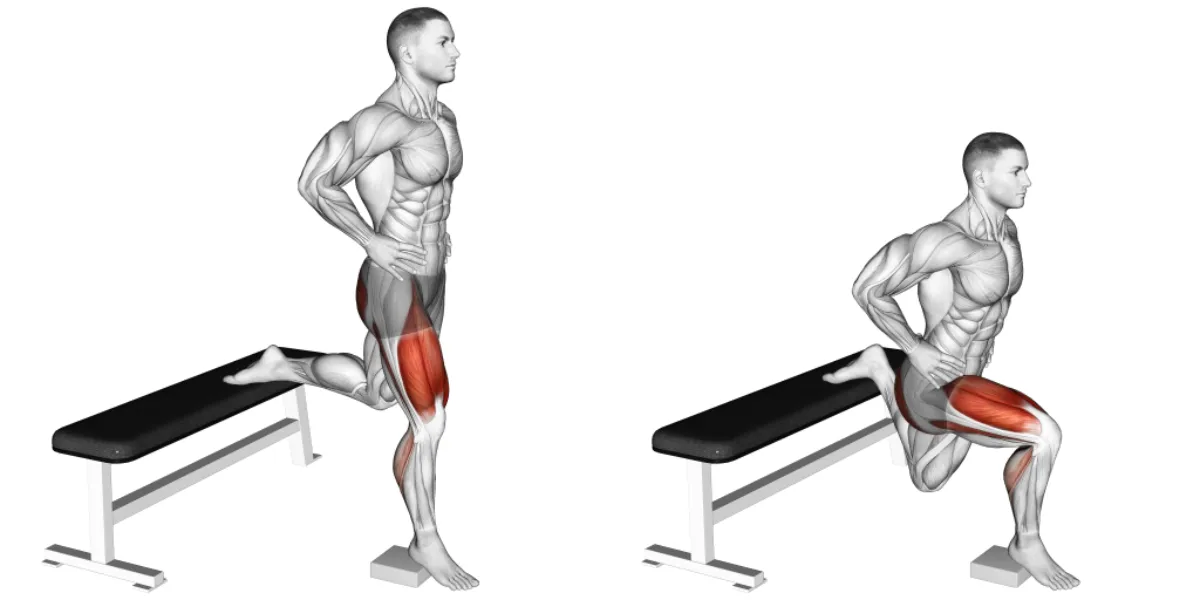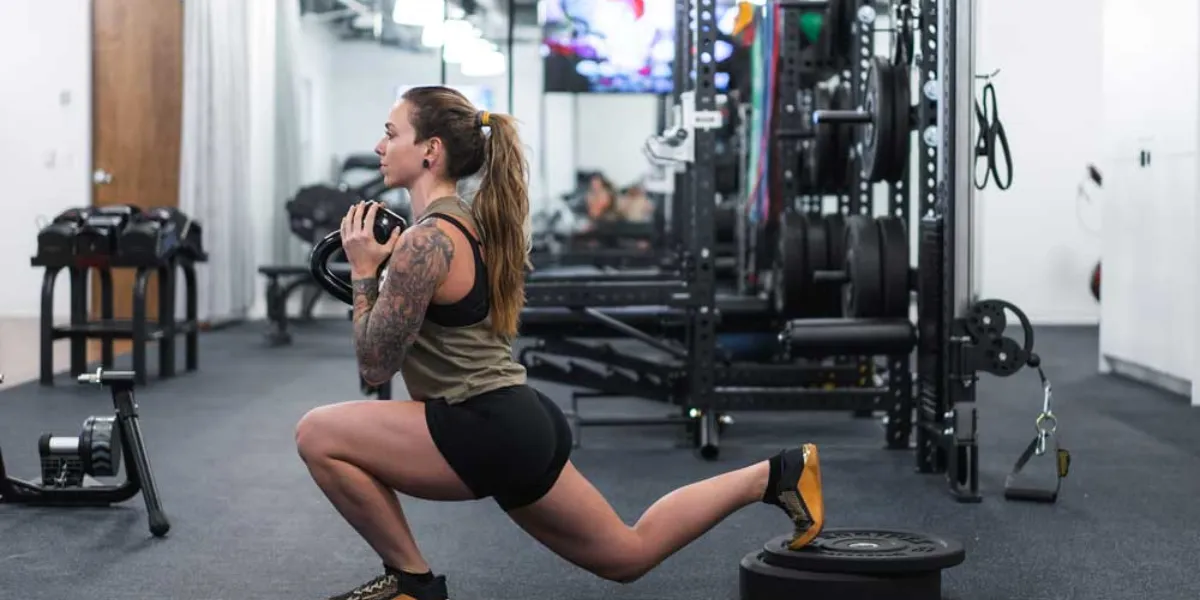The Bulgarian split squat, also known as the single-leg squat with a rear foot elevated, is a fantastic exercise for building lower body strength and stability. It targets your quads, hamstrings, glutes, and calves, making it a well-rounded addition to any workout routine.
This exercise is particularly beneficial for athletes and individuals looking to improve their balance, coordination, and single-leg power.
Benefits of the Bulgarian Split Squat:
- Increased Lower Body Strength: By working each leg independently, the Bulgarian split squat helps develop strength imbalances and build overall leg power.
- Improved Balance and Stability: The single-leg nature of the exercise challenges your core and improves your ability to maintain stability during movement.
- Functional Movement Pattern: The Bulgarian split squat mimics real-life movements like lunging and stair climbing, making it a practical exercise for daily activities.
- Reduced Risk of Injury: Strengthening your legs and core can help prevent injuries related to falls or imbalances.
- Scalable Difficulty: You can easily adjust the difficulty of the exercise by using dumbbells, or kettlebells, or varying the height of the elevated surface.
Before You Begin:
- Warm-up: Properly warm up your lower body with dynamic stretches like lunges, high knees, and butt kicks to prepare your muscles for the exercise.
- Find a sturdy surface: You’ll need a bench, chair, or sturdy platform that’s roughly knee-height for you.
- Start light: If you’re new to the exercise, begin with body weight only until you master the proper form.
Table of Contents
ToggleMastering the Bulgarian Split Squat: A Step-by-Step Guide
Here’s a detailed breakdown of how to perform a Bulgarian split squat with proper form:
- Stance and Foot Placement:
- Stand about two feet in front of your chosen elevated surface with your feet hip-width apart.
- Engage your core and maintain a tall posture with your shoulders back and chest lifted.
- Extend one leg back and place the top of your foot on the bench, ensuring your ankle is directly below your knee.
- Lowering Down:
- Keeping your core engaged and back straight, slowly lower your body down as if performing a regular squat with your front leg.
- Focus on pushing your hips back and bending your front knee until your front thigh is nearly parallel to the ground.
- Tip: Maintain a slight forward lean with your torso throughout the movement.
- Maintaining Balance:
- During the descent, avoid letting your knee cave inward or outward. Your front knee should track directly over your toes.
- Use your back leg for light balance, but focus on driving the movement through your front leg.
- The Drive Up:
- Once you’ve reached a comfortable depth, press firmly through your front heel to return to the starting position.
- Maintain a controlled movement throughout the entire rep.
- Repetitions and Sets:
- Aim for 2-3 sets of 8-12 repetitions per leg. As you get stronger, you can gradually increase the weight or reps.
Variations of the Bulgarian Split Squat:
- Bodyweight Squat: This is the basic version, perfect for beginners.
- Dumbbell Split Squat: Hold a dumbbell in each hand at your sides for added resistance.
- Kettlebell Split Squat: Hold a kettlebell racked in front of your chest for a different challenge.
- Bulgarian Split Squat with Bulgarian Bag: Use a Bulgarian bag resting on your upper back for an unstable surface, further enhancing core engagement.
- Bulgarian Split Squat with Barbell: For advanced individuals, you can perform this variation by placing a barbell across your upper back.
Table: Variations of the Bulgarian Split Squat
| Variation | Difficulty | Equipment | Focus |
|---|---|---|---|
| Bodyweight Squat | Beginner | None | Balance, core engagement |
| Dumbbell Split Squat | Moderate | Dumbbells | Lower body strength, core stability |
| Kettlebell Split Squat | Moderate | Kettlebell | Lower body strength, core stability, rotational power |
| Bulgarian Split Squat with Bulgarian Bag | Advanced | Bulgarian Bag | Lower body strength, core stability, balance challenge |
| Bulgarian Split Squat with Barbell | Advanced | Barbell | Increased lower body strength |
drive_spreadsheetExport to Sheets

Bulgarian Split Squat FAQs:
1. How deep should I squat?
Descend until your front thigh is nearly parallel to the ground, but avoid going lower if it compromises your form.
2. Should I feel pain in my knees?
No. If you experience any knee pain during the exercise, stop and consult a healthcare professional.
3. My front heel keeps coming off the ground. What am I doing wrong?
This could be due to a few reasons:
- Limited ankle mobility: If your ankles are tight, it might be difficult to keep your entire foot flat on the ground. Try incorporating some ankle mobility exercises into your warm-up routine.
- Form Issue: Ensure your front knee is tracking directly over your toes and not collapsing inward. This can cause your heel to lift.
- Weight too heavy: If you’re using weights, try reducing them until you can maintain proper form throughout the movement.
4. Can I perform the Bulgarian Split Squat with a deficit?
Yes! An advanced variation involves placing your front foot on a platform that’s slightly lower than the bench, increasing the range of motion. More Exercise Tips
5. What are some common mistakes to avoid?
- Rounding your back: Maintain a tall posture with your core engaged throughout the exercise.
- Letting your front knee cave in: Focus on keeping your front knee tracking directly over your toes.
- Bouncing out of the bottom: Lower yourself down in a controlled manner and push through your heel to return to the starting position.
- Using momentum: Focus on using your leg muscles to perform the movement, not swinging with your upper body.
- Weight on the back leg: Remember, the back leg is primarily for balance, not driving the movement.
6. How can I progress the Bulgarian Split Squat?
- Increase the weight: Once you can perform the exercise with proper form for the desired reps and sets, gradually increase the weight by using dumbbells, kettlebells, or a barbell.
- Slower tempo: Try performing the exercise with a slower, more controlled tempo for an added challenge.
- Increase the range of motion: As mentioned earlier, you can elevate your front foot on a platform for a greater range of motion.
- Bulgarian Split Squat with Bulgarian Bag: This variation adds an element of instability, further challenging your core.
7. Is the Bulgarian Split Squat better than a regular squat?
Both exercises are excellent for building lower body strength. The Bulgarian Split Squat offers the advantage of working each leg independently, which can help identify and address imbalances. It also places a greater emphasis on core stability and balance.
8. I have knee problems. Can I still do Bulgarian Split Squats?
If you have any pre-existing knee conditions, it’s best to consult with a healthcare professional before attempting this exercise. They can advise you on modifications or suggest alternative exercises that are safe for your knees.
9. How often should I perform Bulgarian Split Squats?
You can incorporate Bulgarian Split Squats into your workout routine 2-3 times per week. Allow sufficient rest for your muscles to recover between workouts.
10. Are there any alternative exercises to the Bulgarian Split Squat?
If you find the Bulgarian Split Squat too challenging or are unable to perform it due to limitations, here are some alternative exercises:
- Regular Squats: This is a foundational exercise that targets similar muscle groups.
- Lunges: Another excellent option for working your lower body and core stability.
- Step-ups: This exercise strengthens your quads, glutes, and hamstrings.
Conclusion
The Bulgarian Split Squat is a valuable addition to your leg workout routine. By mastering the proper form and incorporating variations, you can effectively build lower body strength, improve balance and stability, and enhance your overall athletic performance. Remember to start light, focus on form, and listen to your body. With dedication and practice, you’ll be conquering Bulgarian Split Squats in no time!















2 Responses